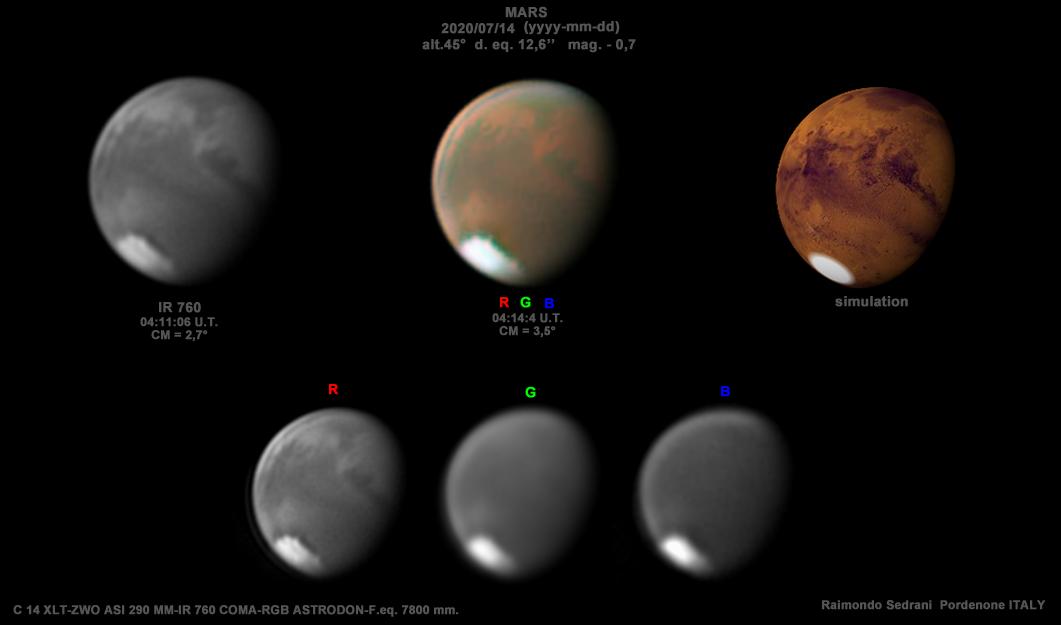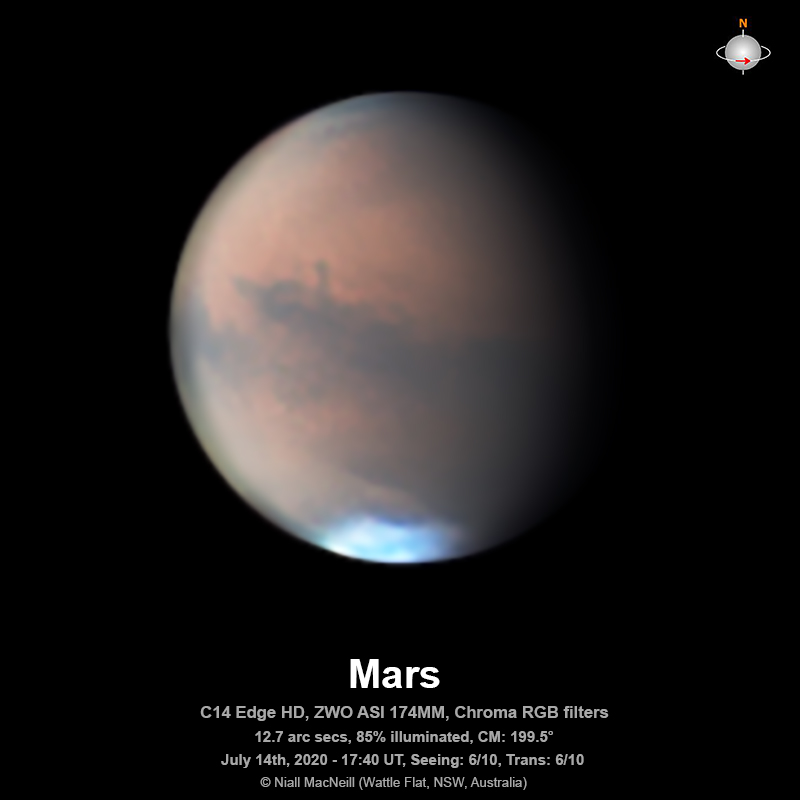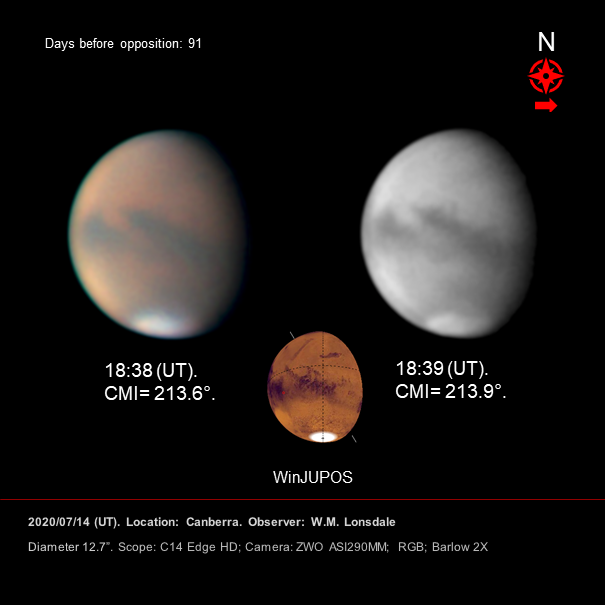火星 ALPO-Japan Latest

Mars Image 2020/07/14(UT)
安達 誠
Raimondo Sedrani,Niall MacNeill,Mark Lonsdale,Mike Hood
R.Sedrani,M.Adachi,N.MacNeill,M.Lonsdale,M.Hood
解説(安達)/ Comment by Makoto Adachi
ダストの濃い部分がヘラス(Hellas;275~315W,-30~60)の東と、アルギレ(Argyre;30W,-50 )付近の2か所になった。7月11日にヘラスの
南東で起こったエッジダストストームの影響を受けたものと思われるが、3日間好条件での観測がなく、残念なことに詳細は分からない。
一方アルギレ付近の様子も、エッジダストストームに起因している。
Niall MacNeill氏の画像では、東に進んでいるダストストームの端が記録されている。この画像は、位置が特定できるので、重要な画像だ。
Mike Hood氏の画像は、ダストの広がりを実によく表現できている。SPC周辺が、極から噴き出した風によって、ダスティーになっている
様子が手に取るようによくわかる。ソリス(Solis Lacus;W90;-28)からシレーン(Mare Sirenum;140W〜170W,-30)にかけて帯状に淡い
バンドができているが、こういった特徴もよく記録されている。また、タルシス(Tharsis;80W〜120W,+10)に斜めに暗いバンドが
見えている。タルシス(Tharsis;80W〜120W,+10)の3つの成層火山の位置に当たるが、東からのダストの縁だろう。西に進んでいく進行方向に、
帯状に大気のクリアな場所ができたのではないかと想像している。
There are two areas of heavy dust, east of Hellas (275~315W, -30~60) and near Argyre (30W,-50). It is thought to have been
affected by the Edge Dust Storm that occurred in the southeast of Hellas on July 11, but unfortunately no details are available
due to lack of favorable observations for three days. On the other hand, the appearance near Argire is also due to the edge dust storm.
Mr. Niall MacNeill's image shows the edge of a dust storm heading east. This image is important because its position can be specified.
Mr. Mike Hood's image really illustrates the dust spread. It is easy to see how dusty around the SPC is due to the wind blowing from
the SPC. A band-like faint band is formed from Solis Lacus (W90;-28) to Mare Sirenum (140W to 170W,-30), but these characteristics are
well recorded. Also, a dark band is diagonally visible in Tharsis (80W to 120W, +10). It corresponds to the position of three stratovolcanoes
of Tharsis (80W to 120W, +10), but it is probably the edge of dust from the east. I imagine that a band of clear atmosphere was
created in the direction of the westward movement.
(by 5 observations; reported by Makoto Adachi)
 -------------------------------------------------------------------------------------
-------------------------------------------------------------------------------------
 [Raimondo Sedrani : Pordenone,Italy]
[Raimondo Sedrani : Pordenone,Italy]
なんと2週間ぶりに火星を見ました。でも、雲の隙間からちらちらと・・・
これではなあ・・と、思いながらも、見たものを頭の中に蓄えて、頭の中で画像処理し、えい、やあ!と描きました。
でも、驚きました。模様が見えないのです。最初は本当に驚きました。
何一つ見えなかったのです。そこで、もう必死になってみていると、だんだん南半球にぼんやりと・・・
視直径はそこそこ大きくなってきているのに、こんなに模様が見えないのはダストベールのせいです。本当に見えませんね。
極冠は、パッと見て小さくなったと思いました。これから一気に進むことでしょう。早く落ち いて観測したいです。
 --------------------------------------------------------------
≪滋賀県 大津市 安達 誠≫[Makoto Adachi:Siga Japan]
--------------------------------------------------------------
≪滋賀県 大津市 安達 誠≫[Makoto Adachi:Siga Japan]
The large albedo area of Mare Cimmerium is central to the image and the iconic SInus Gomer juts up to the north.
The long,thin albedo area which projects from there towards the limb and slightly north is Tritonis Sinus and it stands out quite well.
The Hesperia Planum to its south appears to have light brown tufts of dust clouds,
however,further to the south towards the SPC,a large area of dust cloud is evident.
It extends up from the SPC at the Central Meridian and fans out in the f direction towards the limb,where the Hellas Basin is located.
As we have seen previously there has been evidence of dust clouds there and these are very probably part of the same mass.
The Elysium Planitia to the north,is quite bland and the albedo areas to the south and the f side of Elysium Mons cannot be clearly seen.
 [Niall MacNeill : Wattle Flat,NSW,Australia]
[Niall MacNeill : Wattle Flat,NSW,Australia]
 [Mark Lonsdale : [Canberra,Australia]
[Mark Lonsdale : [Canberra,Australia]
 [Mike Hood : Kathleen Georgia,U.S.A.]
[Mike Hood : Kathleen Georgia,U.S.A.]


-------------------------------------------------------------------------------------
[Raimondo Sedrani : Pordenone,Italy]
-------------------------------------------------------------- ≪滋賀県 大津市 安達 誠≫[Makoto Adachi:Siga Japan]
[Niall MacNeill : Wattle Flat,NSW,Australia]
[Mark Lonsdale : [Canberra,Australia]
[Mike Hood : Kathleen Georgia,U.S.A.]
 ALPO-Japan Latest
ALPO-Japan Latest

 Mars Section
Mars Section